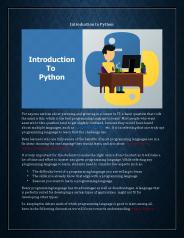Introduction to C Programming - PowerPoint PPT Presentation
Title:
Introduction to C Programming
Description:
A Brief History Created by Dennis Ritchie at AT&T ... (referring to the general standards that appeared in the first edition of Brian Kernighan and Ritchie ... – PowerPoint PPT presentation
Number of Views:47
Avg rating:3.0/5.0
Title: Introduction to C Programming
1
Introduction to C Programming
2
A Brief History
- Created by Dennis Ritchie at ATT Labs in 1972
- Originally created to design and support the Unix
operating system. - There are only 27 keywords in the original
version of C. - for, goto, if, else
- Easy to build a compiler for C.
- Many people have written C compilers
- C compilers are available for virtually every
platform - In 1983 the American National Standards Institute
(ANSI) formed a committee to establish a standard
definition. - Called ANSI Standard C.
- As opposed to KR C (referring to the general
standards that appeared in the first edition of
Brian Kernighan and Ritchies influential book
The C Programming Language)
3
Why use C?
- C is intended as a language for programmers
- BASIC was for nonprogrammers to program and solve
simple problems. - C was created, influenced, and field-tested by
working programmers. - C is powerful and efficient
- You can nearly achieve the efficiency of assembly
code. - System calls and pointers allow you do most of
the things that you can do with an assembly
language. - C is a structured language
- Code can be written and read much easier.
- C is standardized
- Your ANSI C program should work with any ANSI C
compiler.
4
The C Development Cycle
Edit Program
Source Code
Compile
Object Code
Library Files
Executable
Link Object Code
5
Hello World
- Everyone writes this program first
include ltstdio.hgt int main ( ) printf ("Hello,
World!\n") return 0
6
Compilation (1)
- Compilation translates your source code (in the
file hello.c) into object code (machine dependent
instructions for the particular machine you are
on). - Note the difference with Java
- The javac compiler creates Java byte code from
your Java program. - The byte code is then executed by a Java virtual
machine, so its machine independent. - Linking the object code will generate an
executable file. - There are many compilers for C under Unix
- SUN provides the Workshop C Compiler, which you
run with the cc command - There is also the freeware GNU compiler gcc
7
Compilation (2)
- To compile a program
- Compile the program to object code.
- obelix2 gt cc c hello.c
- Link the object code to executable file.
- obelix3 gt cc hello.o o hello
- You can do the two steps together by running
- obelix4 gt cc hello.c o hello
- To run your program
- obelix5 gt ./hello
- Hello World!
If you leave off the -o, executable goes into the
file a.out
8
Compilation (3)
- Error messages are a little different than you
may be used to but they can be quite descriptive. - Suppose you forgot the semi-colon after the
printf - obelix3 gt cc hello.c o hello
- "hello.c", line 5 syntax error before or at
return - cc acomp failed for hello.c
- Notice that the compiler flags and informs you
about the error at the first inappropriate token. - In this case, the return statement.
- Always try to fix problems starting with the
first error the compiler gives you - the others
may disappear too!
9
Example 1
- include ltstdio.hgt
- int main ()
- int radius, area
- printf ("Enter radius (i.e. 10) ")
- scanf ( "d", radius)
- area 3.14159 radius radius
- printf ("\nArea d\n\n", area)
- return 0
10
Example 2
- include ltstdio.hgt
- int main ()
- int i, j
- for (i 0 i lt 10 i)
- printf ("\n")
- for (j 0 j lt i1 j )
- printf ( "A")
- printf("\n")
- return 0
11
Example 3
- / Program to calculate the product of two
numbers / - include ltstdio.hgt
- int product(int x, int y)
- int main ()
- int a,b,c
- / Input the first number /
- printf ("Enter a number between 1 and 100
") - scanf ("d", a)
- / Input the second number /
- printf ("Enter another number
between 1 and 100 ") - scanf ("d", b)
- / Calculate and display the product /
- c product (a, b)
- printf ("d times d d \n", a, b, c)
- return 0
- / Functions returns the product of its two
arguments / - int product (int x, int y)
- return (xy)































